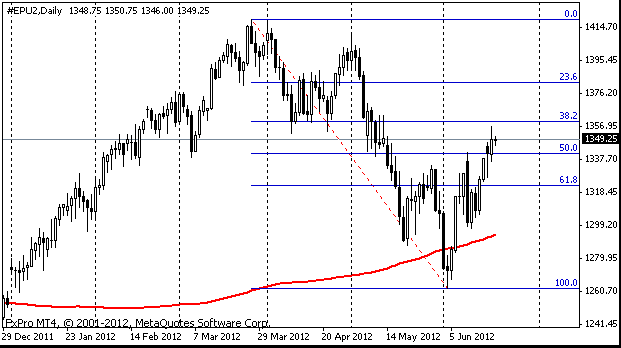EUR/usd
If there's no news, journalists can easily invent it or present one man's opinion as the mood of the whole committee. Thus, yesterday from Der Spiegel it became known that the ECB would probably fix the ceiling of spread deviation between the EU government bonds. Such rumours stirred hope in the markets, supporting the euro and making Spanish bond yields go down. However, the CB didn't let the positive spread, stating that the measure was still to be discussed and that the idea was not an official stance of the Bank, but just the opinion of one of its members. Apparently, the Bank is very likely to take this step, but this is still to be discussed on September 6. Well, the first days of the coming month promise to be really hot. Moreover, we can add here the usual surge of volatility due to the return of trade volumes to the markets after Labour Day in the USA (September 3). However, the market will hardly be still within the next 3 weeks. Now the dollar can take up a defensive position due to the expanding inflation sentiments. The surprisingly low yields of American treasuries have been gradually growing over the recent weeks. For now the scale of this growth can scarcely be called abnormal, this picture sends us back to old correlations when higher inflation provoked drop in the dollar and supported demand for the currencies with higher yields. In the meantime, stocks of American corporations have also been in good demand. As seen, the pair is actively purchased on the dip formed yesterday afternoon. Technically the single currency is still within the upward channel. Now it is more or less clear what is on the ECB's mind and it just remains to see if the northern countries will allow the Bank to implement such a policy. Perhaps they will, as it is more advantageous to use the ECB's balance sheet to buy the bonds than to allocate own money to the bailout funds. It only remains to see if Greece won't spoil the game. This week its leader meets the heads of other nations, the most important meeting is with Merkel on Friday.

GBP/USD
While the euro is gradually purchased by market players on the shifts in the spreads of core and peripheral yields, the British pound also feels quite good. It managed to tear itself off 1.57. The nearest important level is 1.5760. The confident break through this level will be a clear sign of bears' capitulation. You see, in this case the pair will go above 1.57 – the daily closes above this level have been observed only for three times since June. Further we'll also see the break of the 200-day MA and of the triangle within which the pair has been trading all through the summer. The saddest thing for Britain is that the sterling enjoys demand not because of its own merits, but just due to the troubles first of the euro and now of the dollar.

USD/JPY
All strong movements in Forex are followed by rollbacks. The same with USD/JPY. The slight weakening of the dollar was regarded by yen-traders as the right moment to take profits after the powerful yen antirally, which pushed the pair from 78.15 up to 79.65. Technically the pair may go down further to 79.0. At such levels the yen will still be rather expensive, but the very fact that USD/JPY is above the levels seen a year ago allows Japanese exporters to breathe a sigh of relief.

Behind the headlines screaming that Apple now costs more than Microsoft at the peak of the technological bubble, it is not very easy to see the general positive mood of the market. Even despite the daily close at zero. Don't forget that during the day there was a serious drop. However, such drops are quite normal after six positively closed weeks. The highest figure was hit on March 27. Now S&P is just 0.3% away from that high. The next high sends us back as far as May 2008. Yet from the technical viewpoint, at the moment the market looks overbought neither on daily nor on weekly charts.
